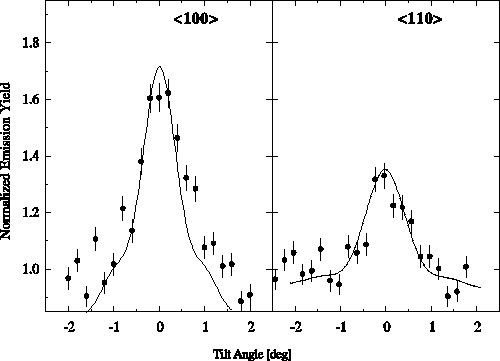
Supported by the BMBF contract No. MA06.06K, the EC contract No. CHRX-CT93-0363 and the MWF-NRW contract No. IV A5-10600294
The probe 77Br(77Se) was implanted into several III-V compound semiconductors like InAs, InP, GaP, GaSb, InSb and GaN. Perturbed Angular Correlation (PAC) measurements carried out after subsequent annealing steps showed that in InP, GaP and InAs well defined Br-defect-complexes are formed with similar characteristics compared to the Br-complex already known in GaAs [1].
Based on theoretical calculations aiming at a description of the properties of the EL2 and DX defects in GaAs, Dabrowski and Scheffler proposed that a double donor incorporated on a group V site (like e.g. BrAs) should exhibit a metastable behaviour similar to the DX centre in GaAs [2]. In one state a neighbouring Ga atom of the substitutional Br probe is displaced along the ⟨111⟩ crystal axis, producing the observed electric field gradient (EFG). The other state corresponds to a cubic environment of the substitutional BrAs donor, where no EFG is present. However, in GaAs the transition to the cubic situation could not yet be observed experimentally by variation of parameters like doping level, optical excitation or sample temperature.
Progress was made in PAC experiments with lightly n-doped InAs, where 25 % of the probe atoms were subjected to a uniform quadrupole interaction (QI) with νQ=370 MHz. The principal component VZZ of the EFG was determined to be oriented along the ⟨111⟩ crystal axis, analogous to the QI in GaAs. However, in earlier experiments with highly n?doped InAs, 100% of the Br probes were found to be incorporated on undisturbed cubic lattice sites. Hence, a III-V compound showing both metastable configurations was found for the first time. Consequently, the Br-related level at which the transition from the relaxed to the substitutional configuration occurs, is apparently much closer to the valence band than expected from theoretical calculations for a DX-type defect. Further PAC experiments, searching for a similar transition in highly n-doped GaAs are planned.
Earlier Emission Channelling experiments, carried out to verify the model, that the EFG observed in GaAs is created by a relaxation of a neighbouring Ga atom insteadof the probe atom itself, have been repeated with a lower implantation energy of the 82Br probes. Corresponding to the lower depth of the implant profile, multiple scattering of the emitted β-particles is reduced and the channeling effect is increased.
 |
The figure 1 shows the channelling spectra after 30 keV implantation and subsequent annealing similar to the samples investigated in the PAC experiments. As expected for a substitutional lattice location of the emitters, a flux peak is observed in the ⟨100⟩ as well as the ⟨110⟩ direction. A quantitative analysis of the data, assuming that the depth distribution of the emitters is not changed during the annealing process, yielded a substitutional fraction of 65±10% of theimplanted Br.
Since diffusion data for the Br-impurity in III-V compounds are not available, Secondary Ion Mass Spectroscopy (SIMS) measurements were performed. After implantation of stable Br (with a dose of 1013 cm-2 at 160 keV) and annealing at 1123 K for 120 s, a significant broadening of the implantation profile was observed. Apparently, Br shows substitutional diffusion in GaAs.
The SIMS data require a recalculation of the theoretical channelling effect, which is expected to result in an increase of the substitutional fraction of the Br emitters deduced from the channelling experiment. The emission channelling experiments therefore support the above mentioned theoretical calculations describing the behaviour of substitutional double donors in III-V compounds.
[1] M. Wehner, P. Friedsam, S. G. Jahn, D. Forkel-Wirth; Mat. Sci. For. 196-201 (1995) 1419
[2] J. Dabrowski, M. Scheffler; Mat. Sci. For. 83-87 (1992) 735